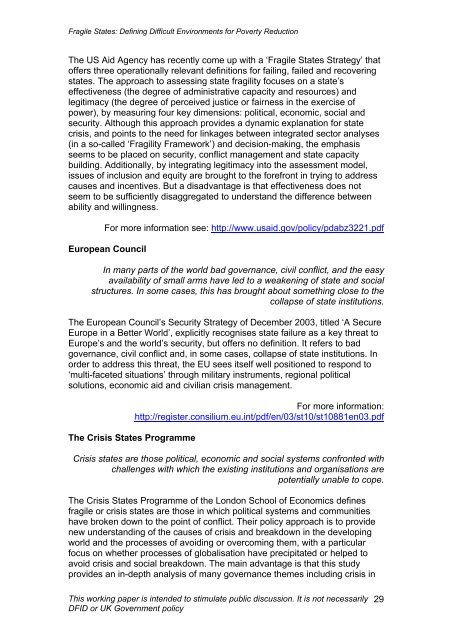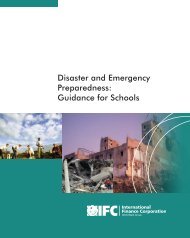Fragile States: Defining Difficult Environments for Poverty ... - INEE
Fragile States: Defining Difficult Environments for Poverty ... - INEE
Fragile States: Defining Difficult Environments for Poverty ... - INEE
Create successful ePaper yourself
Turn your PDF publications into a flip-book with our unique Google optimized e-Paper software.
<strong>Fragile</strong> <strong>States</strong>: <strong>Defining</strong> <strong>Difficult</strong> <strong>Environments</strong> <strong>for</strong> <strong>Poverty</strong> ReductionThe US Aid Agency has recently come up with a ‘<strong>Fragile</strong> <strong>States</strong> Strategy’ thatoffers three operationally relevant definitions <strong>for</strong> failing, failed and recoveringstates. The approach to assessing state fragility focuses on a state’seffectiveness (the degree of administrative capacity and resources) andlegitimacy (the degree of perceived justice or fairness in the exercise ofpower), by measuring four key dimensions: political, economic, social andsecurity. Although this approach provides a dynamic explanation <strong>for</strong> statecrisis, and points to the need <strong>for</strong> linkages between integrated sector analyses(in a so-called ‘Fragility Framework’) and decision-making, the emphasisseems to be placed on security, conflict management and state capacitybuilding. Additionally, by integrating legitimacy into the assessment model,issues of inclusion and equity are brought to the <strong>for</strong>efront in trying to addresscauses and incentives. But a disadvantage is that effectiveness does notseem to be sufficiently disaggregated to understand the difference betweenability and willingness.For more in<strong>for</strong>mation see: http://www.usaid.gov/policy/pdabz3221.pdfEuropean CouncilIn many parts of the world bad governance, civil conflict, and the easyavailability of small arms have led to a weakening of state and socialstructures. In some cases, this has brought about something close to thecollapse of state institutions.The European Council’s Security Strategy of December 2003, titled ‘A SecureEurope in a Better World’, explicitly recognises state failure as a key threat toEurope’s and the world’s security, but offers no definition. It refers to badgovernance, civil conflict and, in some cases, collapse of state institutions. Inorder to address this threat, the EU sees itself well positioned to respond to‘multi-faceted situations’ through military instruments, regional politicalsolutions, economic aid and civilian crisis management.The Crisis <strong>States</strong> ProgrammeFor more in<strong>for</strong>mation:http://register.consilium.eu.int/pdf/en/03/st10/st10881en03.pdfCrisis states are those political, economic and social systems confronted withchallenges with which the existing institutions and organisations arepotentially unable to cope.The Crisis <strong>States</strong> Programme of the London School of Economics definesfragile or crisis states are those in which political systems and communitieshave broken down to the point of conflict. Their policy approach is to providenew understanding of the causes of crisis and breakdown in the developingworld and the processes of avoiding or overcoming them, with a particularfocus on whether processes of globalisation have precipitated or helped toavoid crisis and social breakdown. The main advantage is that this studyprovides an in-depth analysis of many governance themes including crisis inThis working paper is intended to stimulate public discussion. It is not necessarilyDFID or UK Government policy29
















